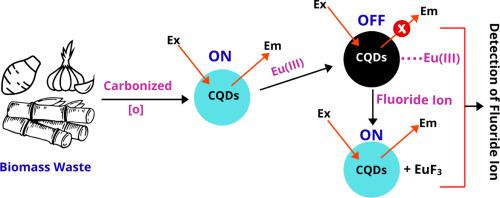Journal of Photochemistry and Photobiology B: Biology ( IF 3.9 ) Pub Date : 2020-06-21 , DOI: 10.1016/j.jphotobiol.2020.111940 Anusuya Boruah 1 , Monikankana Saikia 2 , Tonkeswar Das 1 , Rajib Lochan Goswamee 3 , Binoy K Saikia 2

|
Carbon quantum dots (CQDs) are among the most feasible allotropes of carbon-based nanomaterials with unique characteristics of photoluminescence, bio-compatibility, and high stability. Herein, a green and eco-friendly approach has been propagated for the fabrication of CQDs from different biomass waste materials including sugarcane bagasse (SCB), garlic peels (GP), and taro peels (TP) by using ultrasonic-assisted wet-chemical-oxidation method. This top-down approach involves oxidation of the carbonized biomass wastes by H2O2. Another purpose of our work is to make a comparative study on the three CQDs produced from the three different biomass wastes. The properties of the fabricated CQDs were evaluated by using High Resolution-Transmission Electron Microscopy (HR-TEM), Fourier Transform-Infrared (FT-IR) spectroscopy, X-ray Diffraction (XRD), and X-ray Photoelectron spectroscopy (XPS), respectively. The CQDs showed the characteristic photo-physical behaviours as evident from the UV–visible and fluorescence (FL) spectroscopic analyses. The CQDs are found to be highly water soluble possessing strong blue-fluorescence under UV light with excellent quantum yield around 4–27%. The comparative study on the different physico-chemical properties of the three wastes biomass-derived CQDs are also discussed in the paper. The FL properties of CQDs derived from taro peels waste shows the best fluorescence quantum yield among the three and keeping in view of this, an on−off−on fluorescence nanoprobe was designed by using taro peels-derived CQDs (i.e. T-CQDs) and Eu3+ ion. The FL emission of T-CQDs was observed to be significantly quenched by Eu3+ leading to the formation of a CQDs-Eu3+ nanoprobe. The CQDs-Eu3+ nanoprobe was promisingly used for sensing of fluoride ions in water.
中文翻译:

废物生物质来源发出的蓝色荧光碳量子点及其在水中氟离子检测中的应用。
碳量子点(CQD)是碳基纳米材料最可行的同素异形体,具有光致发光,生物相容性和高稳定性的独特特征。本文介绍了一种绿色环保的方法,该方法通过使用超声辅助湿化学法从包括甘蔗渣(SCB),大蒜皮(GP)和芋头皮(TP)在内的不同生物质废料制造CQD。氧化法。这种自上而下的方法涉及通过H 2 O 2氧化碳化的生物质废物。我们工作的另一个目的是对由三种不同生物质废物产生的三种CQD进行比较研究。通过使用高分辨率透射电子显微镜(HR-TEM),傅立叶变换红外(FT-IR)光谱,X射线衍射(XRD)和X射线光电子能谱(XPS)来评估所制造的CQD的特性, 分别。CQD显示出特征性的光物理行为,从紫外可见和荧光(FL)光谱分析可以明显看出。CQD被发现是高度水溶性的,在紫外线下具有很强的蓝色荧光,量子产率约为4–27%。本文还讨论了三种废物生物质衍生的CQDs不同理化性质的比较研究。3+离子。观察到T-CQDs的FL发射被Eu 3+显着淬灭,导致形成了CQDs-Eu 3+纳米探针。CQDs-Eu 3+纳米探针有望用于感测水中的氟离子。











































 京公网安备 11010802027423号
京公网安备 11010802027423号